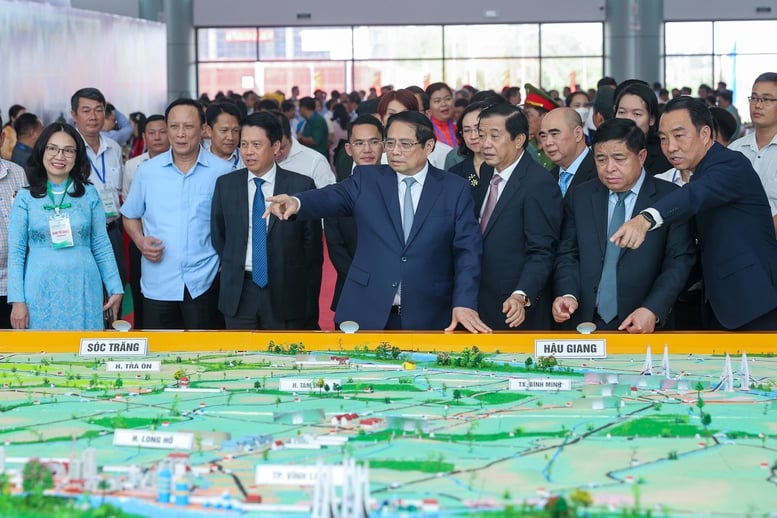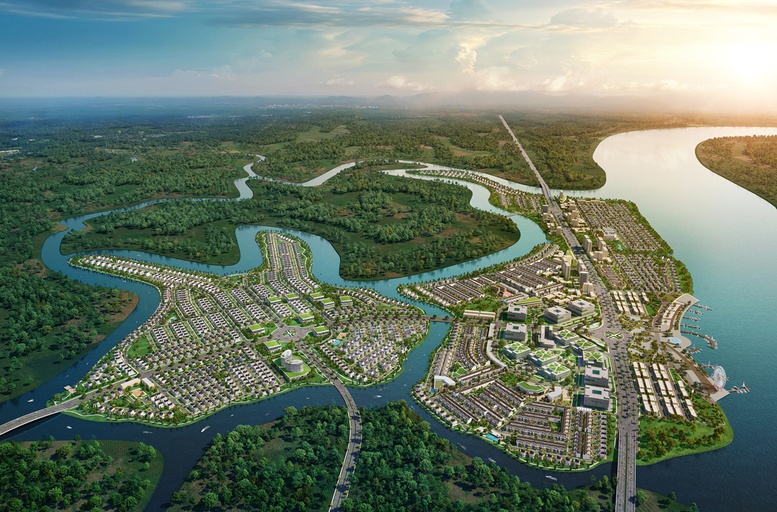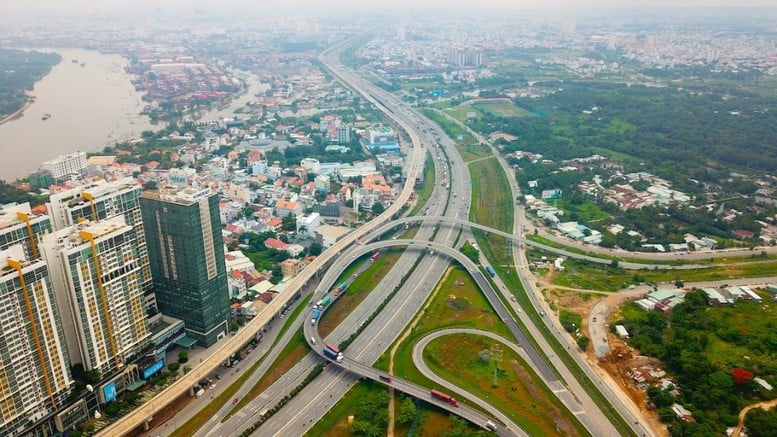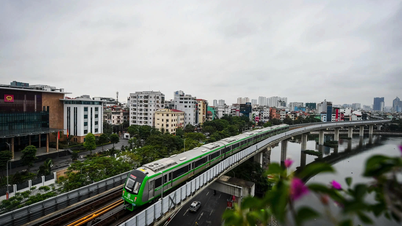
Prime Minister Pham Minh Chinh has clearly stated the direction: Management agencies develop plans, standards, regulations, and other necessary conditions, then publicly announce them, and people and businesses just follow them - Photo: VGP: Prime Minister Pham Minh Chinh views the planning model of Vinh Long province
This is not an isolated case. Many other businesses have encountered similar situations when they want to invest in projects but are stuck because the planning is not updated in a timely manner or is not suitable for the development reality.
The 2017 Planning Law was expected to create an important institutional turning point: replacing hundreds of fragmented, overlapping plans with an integrated, unified, and transparent system. However, after more than six years of implementation, this law, once hailed as a "planning revolution", has shown shortcomings.
Meanwhile, Vietnam is implementing the merger from 63 provinces and cities to 33 provincial-level units, in order to increase scale, increase internal strength and management efficiency. This administrative restructuring process will certainly entail the need to adjust the planning of provinces and regions, posing a test for the adaptability and flexibility of the current Planning Law.
In that context, it is necessary to objectively review the advantages and limitations of the Planning Law to prepare for the upcoming reform roadmap. Limitations, inadequacies and obstacles to development must be eliminated.
The undeniable bright spots
The 2017 Planning Law was issued in the context that Vietnam is facing the problem of overlapping and fragmented planning. The establishment of a national planning system at 3 levels (national, regional, provincial) has contributed to shaping the institutional order for different planning, avoiding the situation where planning for resources, land, infrastructure, and construction are contradictory and conflicting with each other.
The law also requires publicizing planning on the National Planning Portal, laying the foundation for building a digital database and making it easier for businesses and people to access information. Some localities leading in planning such as Quang Ninh and Long An have taken advantage of the opportunity to build a systematic development vision.

Many businesses face a dilemma when investing in projects that are stuck due to planning that is not updated in a timely manner or is not suitable for development reality.
Practical shortcomings need to be frankly acknowledged
First, the integrated model is over-idealized. Combining all types of planning into one integrated plan is not suitable for the characteristics of each field and locality. Each type of planning has different methods of preparation, time limits, and goals. Forcing integration into a single mold can easily lead to formality, confusion, and difficulty in adjusting when there are changes in reality.
Second, there is a lack of clear regulations on the relationship between planning levels – from national master planning to sectoral planning and local planning. This causes difficulties in the implementation process, leading to a situation of waiting for each other between levels and sectors.
Third, the Law does not fully address zoning and detailed planning – which are essential tools in implementing urban development, land allocation and investment attraction. This absence paralyzes the specific management capacity of the grassroots level, leaving localities "bare-handed" in managing development space.
Fourth, the current planning adjustment faces many administrative procedures, even having to be submitted to the central government, causing many investment projects to stall. Not only that, local authorities also have to spend money to hire consultants, update data, ask for opinions... resulting in large costs in terms of time and finance.
Fifth, local planning often does not integrate or "forgets" to integrate the planning of previously approved projects, leading to businesses turning right into wrong in planning. Businesses have to run around to integrate the project planning with local planning. There is another jungle of procedures to overcome, wasting time, opportunities and incurring many additional costs...
Lessons from the world : Flexibility, decentralization and transparency
In reality, there is no perfect integrated planning model in the world. But there are countries that have been very successful in regulating planning flexibly and effectively.
In the Netherlands, national planning only plays a strategic guiding role – defining development corridors, ecological zones, energy, urban areas, etc. Localities have full authority to implement detailed planning, as long as it does not conflict with the general framework. This creates necessary flexibility and encourages local creativity.
South Korea maintains many types of planning simultaneously – from regional development planning to specialized planning. When there are conflicts between plans, the country does not "force integration" but has a flexible reconciliation and adjustment mechanism.
Singapore goes further: all planning is digitized and published on a digital map platform for the entire population, investors and public authorities to access, comment, monitor and update. The preparation and approval procedures are minimized thanks to a synchronous technology system and high technical capacity.
The lesson is clear: integration is not achieved by administrative orders, but by data tools, transparency and clear decentralization.

Planning must return to its proper role: as a guiding vision, a tool for organizing development space, and a driving force for the nation to rise.
Recommended amendment: To make planning a driving force for development
Firstly, it is necessary to redesign the Planning Law according to the model of stratification - coordination - decentralization. In which, the central level sets strategic directions, ministries and branches develop their own sectoral plans, and localities focus on zoning, detailing and implementation plans.
Second, re-legislate zoning and detailed planning as planning levels with clear legal value, giving management tools to the grassroots level.
Third, instead of rigid integration, it is necessary to allow the existence of multiple planning layers that can dialogue and adjust each other through planning reconciliation mechanisms.
Fourth, decentralize substantially to localities in adjusting planning to shorten response time to investment and innovation opportunities.
Fifth, promote digitalization and publicization of planning data, connect information systems between levels and sectors to create a foundation for transparency and effective coordination.
As Prime Minister Pham Minh Chinh recently stated very clearly the breakthrough direction: Management agencies develop plans, standards, regulations, and other necessary conditions and then publicly announce them; people and businesses just follow the plans, regulations, standards, and conditions, doing what the law does not prohibit; and instead of having to pre-check and grant licenses, the government strengthens post-check, inspection, and supervision.
Reform to not miss the development beat
The Law on Planning is a major effort in institutional reform. However, because of high expectations, when not properly implemented, the consequences are even more serious. In the context of Vietnam's strong transformation with administrative merger programs, attracting strategic FDI, large-scale infrastructure development and comprehensive digital transformation - planning cannot become an obstacle.
It is time to amend the law – not to negate the initial reform efforts, but to perfect the institutions in line with reality and development aspirations. Planning must return to its proper role: as a guiding vision, a tool for organizing development space, and a driving force for the nation to rise.
Dr. Nguyen Si Dung
Source: https://baochinhphu.vn/de-quy-hoach-tro-thanh-dong-luc-phat-trien-102250526063157903.htm




![[Photo] Pink ball and table tennis](https://vphoto.vietnam.vn/thumb/1200x675/vietnam/resource/IMAGE/2025/5/26/d9f770bdfda243eca9806ea3d42ab69b)
![[Photo] French President Emmanuel Macron and his wife begin state visit to Vietnam](https://vphoto.vietnam.vn/thumb/1200x675/vietnam/resource/IMAGE/2025/5/25/03b59c7613144a35ba0f241ded642a59)




















![[PHOTO] Hanoi fences off demolition of "Shark Jaws" building](https://vphoto.vietnam.vn/thumb/1200x675/vietnam/resource/IMAGE/2025/5/25/1b42fe53b9574eb88f9eafd9642b5b45)
![[Photo] Ea Yieng commune settlement project abandoned](https://vphoto.vietnam.vn/thumb/1200x675/vietnam/resource/IMAGE/2025/5/25/57a8177361c24ee9885b5de1b9990b0e)




























![[Infographic] Vietnam-France Comprehensive Strategic Partnership](https://vphoto.vietnam.vn/thumb/402x226/vietnam/resource/IMAGE/2025/5/26/986f63068ea9413dbbb558ee6c6944f3)


































Comment (0)